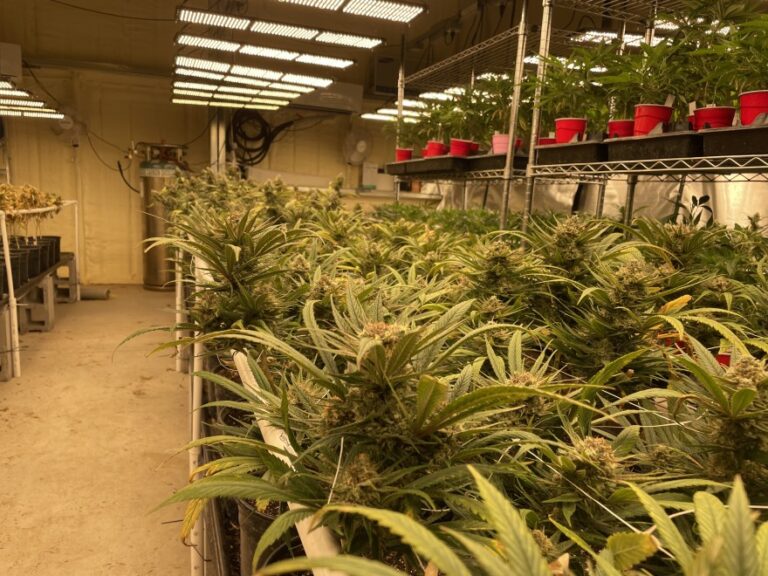STILLWATER, Okla. — The medical marijuana industry in many areas is booming, but some utility providers struggle to keep up with the growing need for water and electricity.
Since Oklahomans legalized medical marijuana in 2018, nearly 10% of the population has obtained cards to buy cannabis. Meanwhile, 8,630 growers have opened shop in the state.
The Oklahoma Medical Marijuana Authority gives growing licenses to cannabis farmers, but it doesn’t regulate how much electricity or water the growers use, leaving it up to local utilities to decide what to do.
“We’ve got water systems that were built 50 to 60 years ago being asked to perform to standards today that are just outside of its capacity,” says Sheldon Tatum, who manages a rural water district in Hughes County, Oklahoma.

Over the past nine months, eight cannabis growers have moved into his service area. He says one of the farms used 223,000 gallons of water in August.
For Tom Whitaker, manager of a rural water district in Wynnewood, Oklahoma, it comes down to supply. Based on the numbers he’s seeing, he likely will run out of water.
He says he’s already sold 42 million gallons of water so far this year, and he anticipates that number will double by December.
Whitaker says he fears he will get too close to the 130 million gallons the Oklahoma Water Resources Board has allocated the district. That’s why he says he’s cut off some farms at 10,000 gallons a month.
“If I start over pumping … I start robbing from my neighbor over here, and then he don’t [sic] have any water,” Whitaker says. “And then pretty soon nobody has water. And that’s our challenge.”
Like any plant, cannabis needs water to grow, but Chris Dillis, a researcher at the University of California, Berkeley, says it’s no different from other irrigated crops.
“When cannabis is grown in areas that are more home to traditional agriculture, it’s really not all that different from other crops in terms of water requirements,” Dillis says.
But not all cannabis farms are using that much water. Outside Stillwater, Oklahoma, Iris Farms grows about 5,000 marijuana plants in a large metal building. Head grower Adam Miller says he fills up two 55 gallon tanks to water the plants.
“I’m watering individual plants, you know, half gallon of water at a time, and they’re irrigating a field and the space between the rows and everything else is absorbing all that water,” Miller says. “So they just have to use a whole lot of it.”

The monthly water bill at Iris Farms is only about $40, each month but with lighting and fans, the electric bill can be as high as $3,000.
Rural electric cooperatives are facing challenges that come with providing the necessary electricity for large indoor growing operations. Logan Pleasant, the director of operations at Lake Region Electric Cooperative, says there are more than a hundred growers that use their electric system.
“Most of these large growers that have come in have requested somewhere between a one- and two-megawatt load,” Pleasant says. “So if you add them all up, these growers are using as much power as a small city.”
Pleasant says they’ve started requesting that the indoor farms use electrical engineers and designers to get a more accurate picture of electric needs. That’s helped, but it has only gone so far, he says.
“Unfortunately, when the rubber meets the road, even though they’ve gone out and asked these engineering firms to help them figure out what they need, once they start construction, they’re not following the plans,” Pleasant says. “And that’s been kind of a challenge for us.”
If the requests keep up, Pleasant says the co-op will have to buy new substations and even install new power lines. That would cost hundreds of thousands of dollars, and the price tag would be shared by each member of the co-op.

If the marijuana boom turns into a bust, that could leave other customers footing the bill.
“Many of these locations will either close up shop, or they will scale back significantly if the market wanes,” Pleasant says.
That’s a real concern.
“There are far too many growers. There are far too many dispensaries in that state, for the number of patients that there are,” says John Hudak, who studies marijuana policy as a senior fellow at the Brookings Institution.
He says Oklahoma has the fewest restrictions on growing in the country.
“Which also means that your costs are naturally lowered, fewer regulations translate to fewer costs,” Hudak says. “So that’s something that I think a lot of growers will see as a positive.”
The Oklahoma Medical Marijuana Authority says it is planning to work closely with the utilities and the state’s water and energy boards to find solutions.
For now, utility managers are faced with difficult decisions on how to meet the demand for water.
“Do I want to go borrow a million dollars and develop another well, so I can have more quantity to provide? And then we don’t know if they’re [marijuana farms] going to be here in three years, five years,” Tatum asks. “And I’m carrying a million-dollar mortgage for 40 years? Is it fair for existing customers to bear that burden? So there’s a lot of questions that come into play on how things are managed, how things are operated.”

